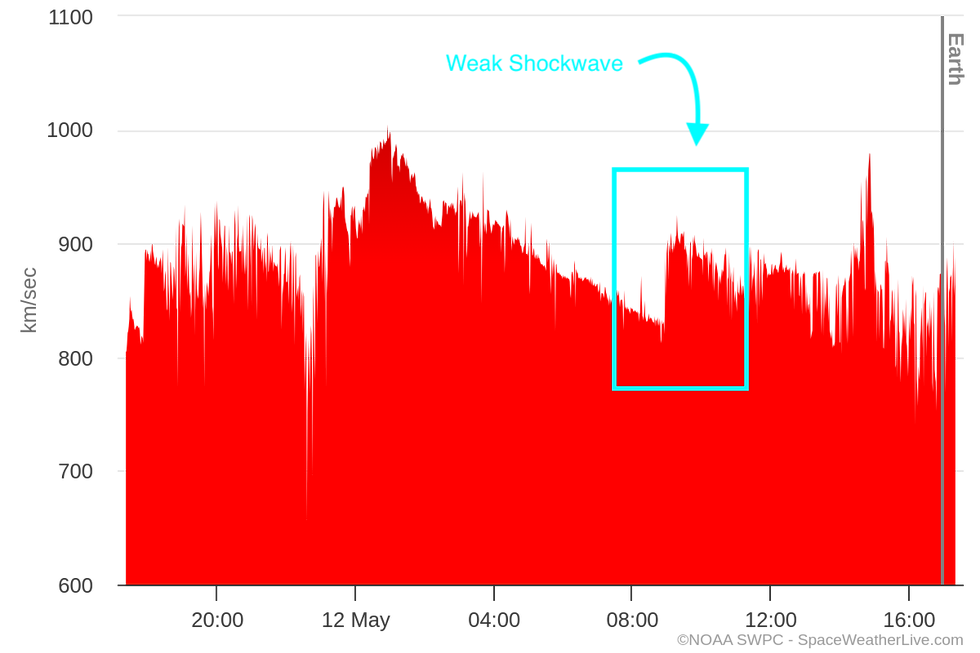Monday Morning Forecasting: An analysis of this weekend's solar storm.
- alexandercatullo
- May 12, 2024
- 4 min read
Updated: May 13, 2024
This has been a historic weekend for aurora chasers, with the public taking so much interest in the Northern Lights that they literally broke the SWPC website with traffic. Those who looked for the lights on Friday were rewarded with a spectacular show, and with an even stronger forecast for Saturday night, countless newly-minted aurora chasers looked to the skies in hopes of an encore.
But alas, a repeat was not in the stars for those chasers. Conditions barely broke Kp 7 during Saturday night, which is still impressive, but not as strong as the predicted Kp 9+ conditions which would have brought the lights to almost every American city. I have to imagine that a lot of new chasers were frustrated by this, and may want to understand why the forecast can nail it one day, and utterly fail the next. The simple answer is that space weather is hard, but below we'll take a look at the key differences between Friday and Saturday night, and how the forecasts shaped up.
CME Timing
The reason that Saturday's conditions fizzled is due to the late arrival of a Coronal Mass Ejection that was supposed to enhance the solar storm. Forecasters knew from spacecraft data that a few days ago, a particularly active region of the sun was erupting solar matter into space. These Coronal Mass Ejections (or CMEs), can cause an increase in auroral activity when they collide with Earth. Space Weather Prediction Center (SWPC) forecasters reasoned that the arrival of these CMEs would cause a boost in geomagnetic storming up to G5 conditions:
SWPC Forecast Discussion 2024 May 12 0030 UTC
Periods of G4-G5 (Severe-Extreme) geomagnetic storms are likely on 12 May due to continued CME activity and the anticipated arrival of another series of CMEs associated with eruptive activity from Region 3664 over 09-11 May.SWPC does their best to model how fast these CMEs will reach earth, but the tools at their disposal are limited. Often times a CME (or series of CMEs in this case) can arrive later than predicted, or not at all. In the case of Saturday night, a CME impact shockwave did not arrive until about 5am New England Time, and even then, the effect on the solar wind was fairly weak.
In the graphs below you can compare strength and arrival times of the Friday and Saturday CMEs, note that Saturday's was both later and weaker than predicted:
Solar Windspeed: Friday Shockwave

Solar Windspeed: Saturday Night/Sunday Morning 5am (ET) Shockwave

One thing to note about these graphs is that through Friday and Saturday, the solar wind speed was still pretty high, with or without the shockwave. With speeds like this, you can still expect to get enhanced geomagnetic storming, but one key element was missing on Saturday night, and that's the Bz component.
Magnetic Configuration: The Bz component
Magnetic configuration is everything when it comes to auroras, and Saturday night's configuration was just not conducive to enhanced northern lights.
When a CME arrives at earth, it arrives as a tangled mass of magnetic field lines. Within all that magnetism, there is one key component that determines auroral activity: the north-south orientation of the incoming magnetic field, called the Bz component. For good auroral displays, the Bz needs to be oriented southwards in order to connect with earth's own magnetic field, in the same way that two magnets of opposite polarity connect. The chart below shows the Bz graph line for Friday, where negative values in red represent southwards Bz. We can see that when the solar storm hit on Friday, the Bz dipped strongly southwards into the red, lighting up the sky through the night:

On Saturday night however, while the windspeed was still high, the Bz spent a lot of time in the northwards direction, diminishing chances of auroral displays:

Generally, the further south the Bz goes, the stronger the aurora will be. The values near -50 we saw on Friday were truly extraordinary, leading to the historic auroras we saw that night.
Forecasting Challenges
Unfortunately, for all its importance the Bz is incredibly hard to predict, which is the main reason why even the best forecasts turn out to be a bust. When CMEs are first launched, forecasters get one look at them through coronagraph images of the sun, and then that's it until the solar storm is on our doorstep. The coronagraph image can help predict the speed, direction, and arrival time of a CME, but it says next to nothing when it comes to Bz.
Days after an earth-directed CME is launched and it finally arrives, it will first pass the ACE and DSCOVR spacecraft. These satellites orbit in such a way that they give us a half-hour heads up about solar windspeed, density, and Bz configuration; but from the time the CME launches to the time it passes DSCOVR, forecasters are basically in the dark and all we can do is wait.
I liken the challenge of space weather prediction to the task of predicting the terrestrial weather in New England using a tiny amount of data from a single weather station in California. It's hard, and the Space Weather Prediction Center is primarily concerned with protecting life and property. It's in their best interest to warn of strong CME impacts, even if we don't know if the Bz will be positive or negative. In the case of this weekend's solar storm, the potential existed for two straight nights of epic light shows, but as we learned later, the stars were not aligned.
This post uses images and data from both https://www.swpc.noaa.gov/ and https://www.spaceweatherlive.com/.



Comments